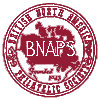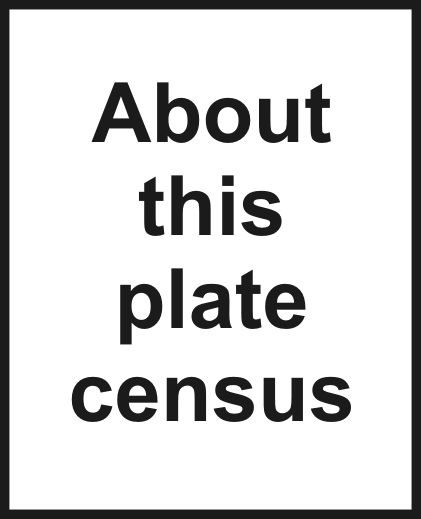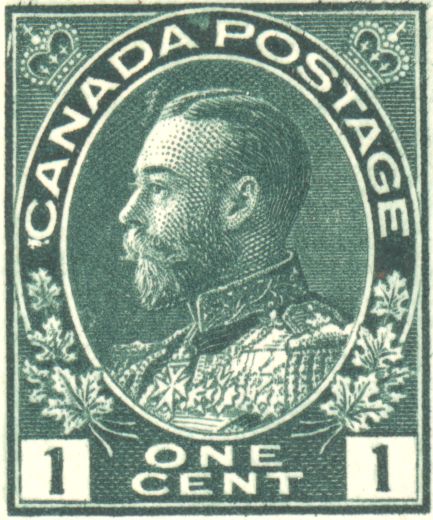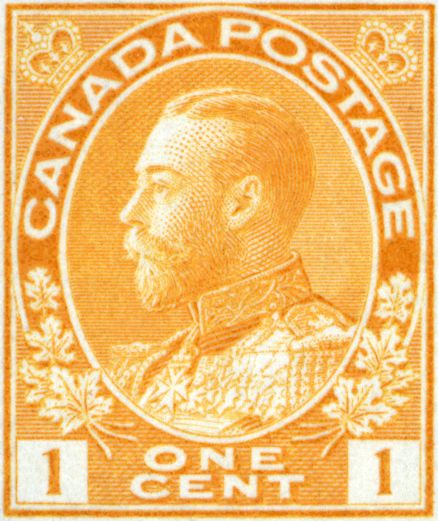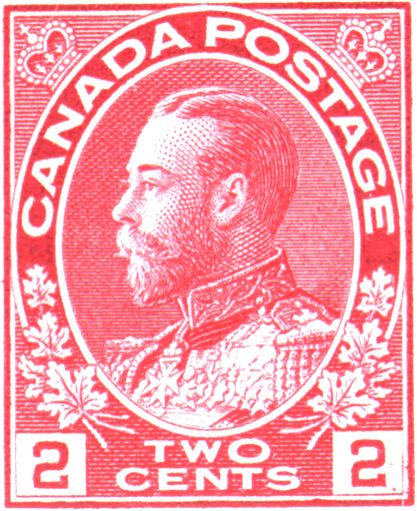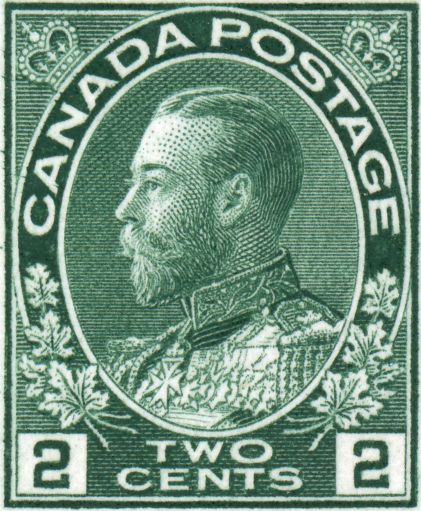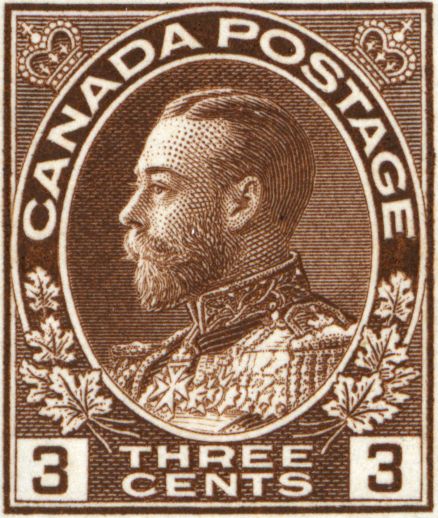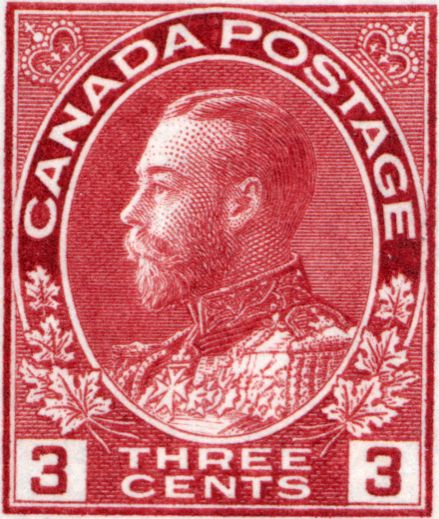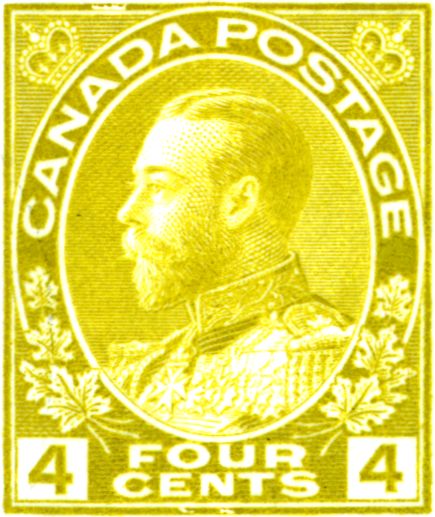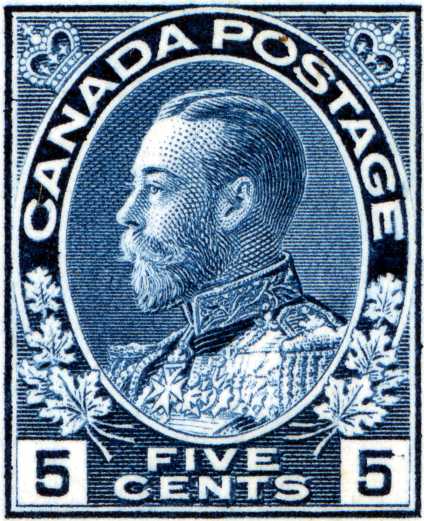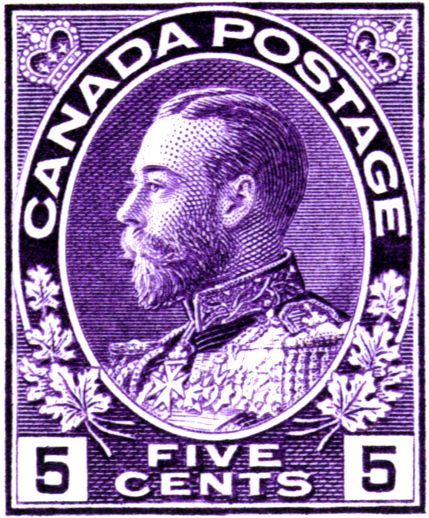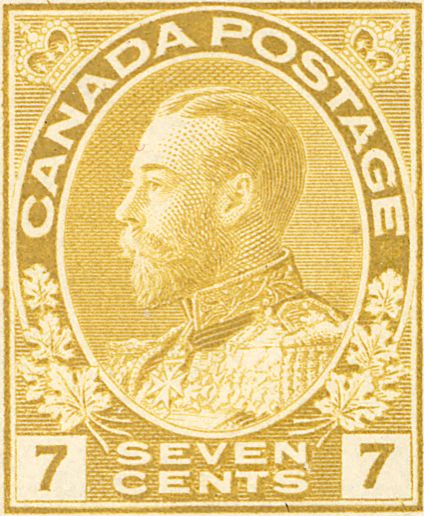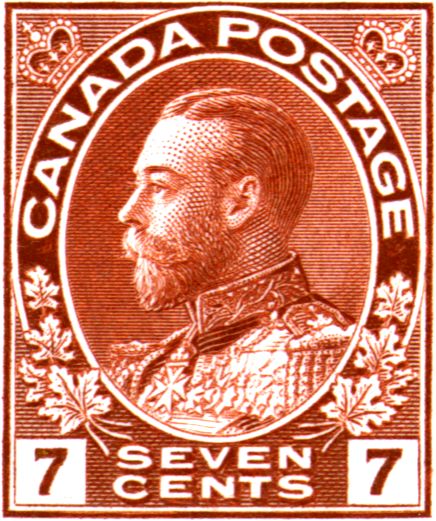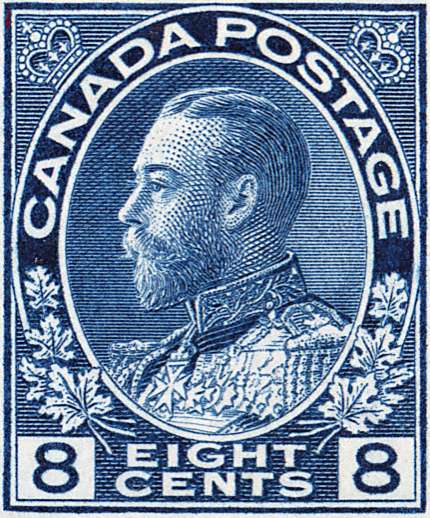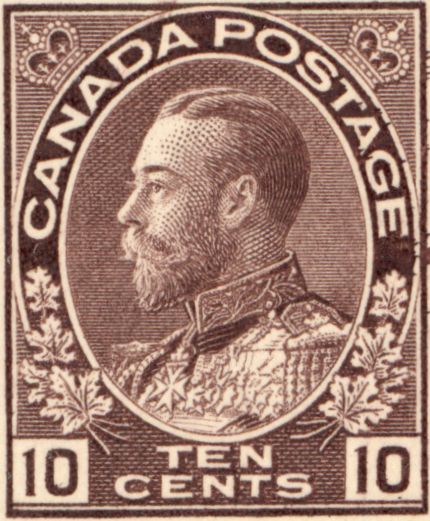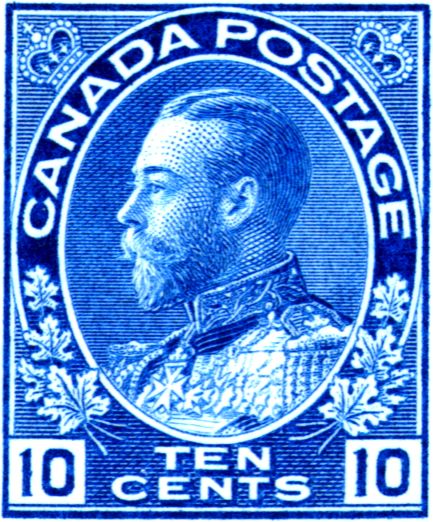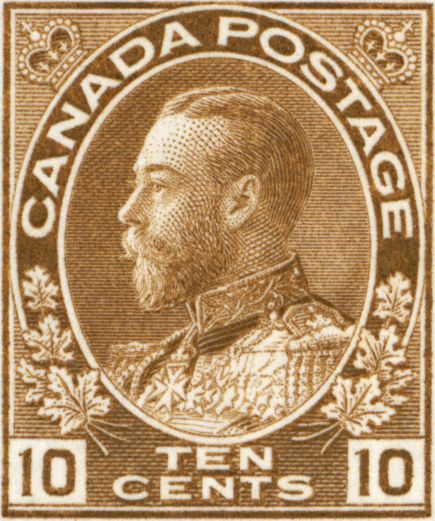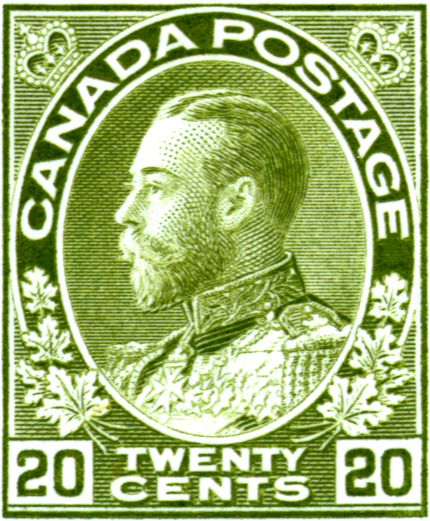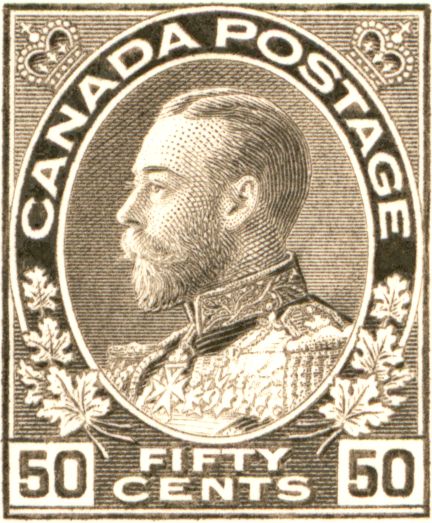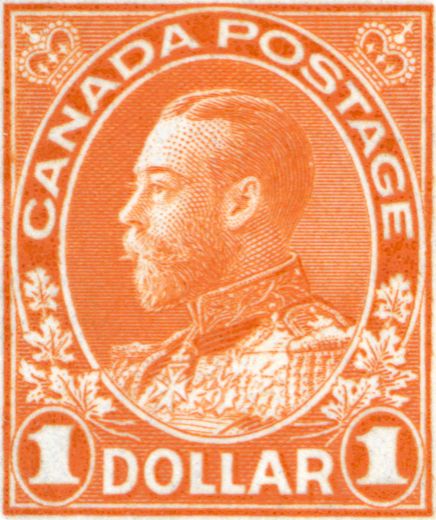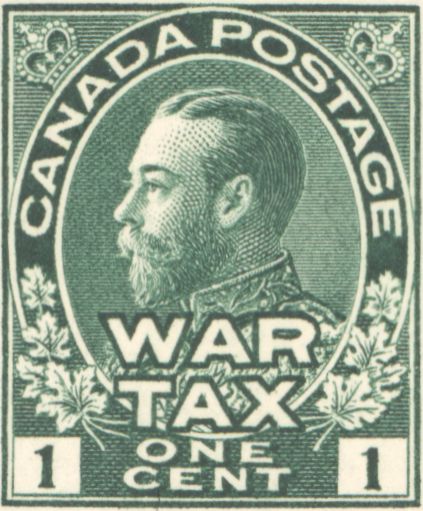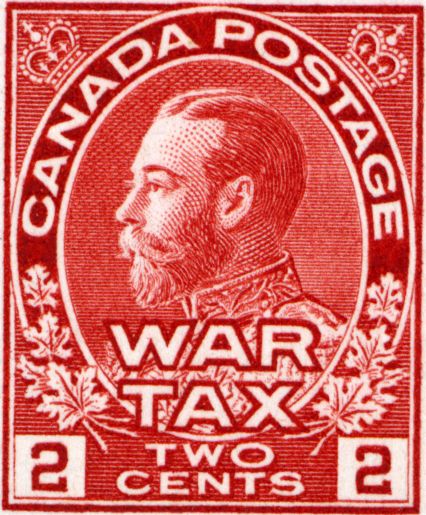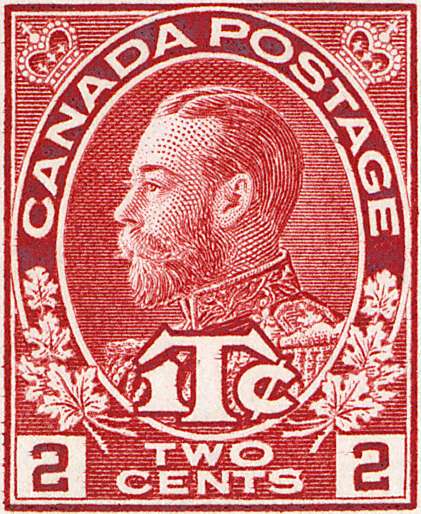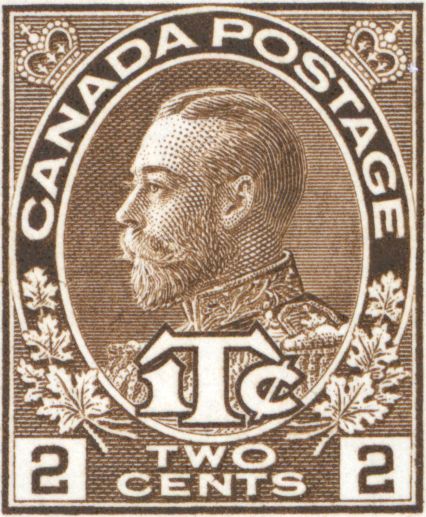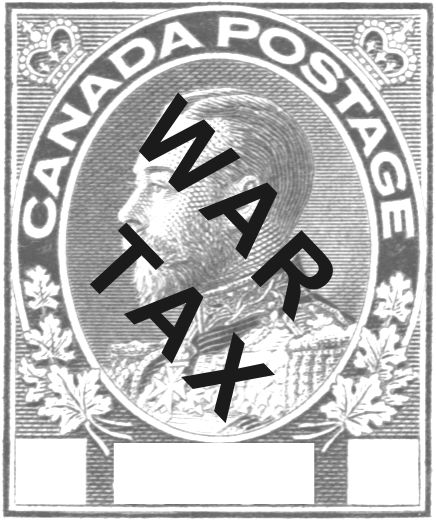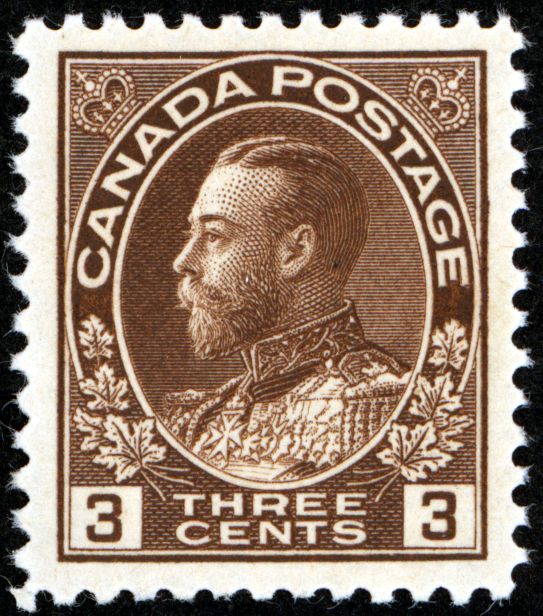
In column 2 of the table, the heading "PO" stands for Printing Order. Beginning in February 1911, near the end of the KE VII period, until March 1915, the printing order number was hand punched on the plate, usually near the plate imprint. In March 1915, it was engraved on the plate in the pane selvedge above and/or below column 9 or 10. If a plate was used for more than one printing order, the old number was defaced and the new one punched in. In the table, only the number that is not defaced is listed.
Beginning with the 2¢ carmine in November 1915, the "printing order number" consisted of a number that indicated the stamp denomination and issue format (sheet, coil, or booklet) and one or two letters that indicated the printing order. The number did not change and the letters were not defaced. The PO column of plates with this new numbering scheme is greyed out.
In the three "Upper" and "Lower" columns, the size of each item is indicated by a letter and number. The letter indicates the configuration:
- ► S = Strip
- ► B = Block
The number following the letter is the number of stamps in the strip or block. If there are multiple items of the same size, the size is in parentheses, and the number preceding the parentheses is the number of items. For example, 4(B8) indicates that there are four blocks of 8 of a certain item. S1 indicates a "strip" consisting of a single stamp. B100 is a complete pane.
A grey cell indicates that the item does not exist. A light blue cell indicates that no material from the plate was reported in this census.
| Plate | PO | Wet Dry |
Total | Upper | Upper Left | Upper Right | Lower | Lower Left | Lower Right |
|---|---|---|---|---|---|---|---|---|---|
| 1 | W | 5 | 2(S2),B8 | B10 | B20 | ||||
| 2 | W | 3 | B4,B8 | B20 | |||||
| 3 | W | 9 | 3(S2),S4,B4 | S4,2(S10),B6 | |||||
| 4 | W | 8 | 3(S2) | S4,S10,B4 | S4,B4 | ||||
| 5 | W | 2 | S2 | S10 | |||||
| 6 | W | 3 | S3,2(S10) | ||||||
| 7 | W | 2 | S3 | S4 | |||||
| 8 | W | 1 | S10 | ||||||
| 9 | W | 4 | S2 | S4,B6,B18 | |||||
| 10 | W | 5 | 3(S2) | B20 | S4 | ||||
| 11 | W | 3 | S2 | B8,B20 | |||||
| 12 | W | 3 | 2(S2),B4 | ||||||
| 13 | W | 3 | B4 | S4,B20 | |||||
| 14 | W | 2 | S2 | S4 | |||||
| 15 | W | 3 | S2 | 2(S10) | |||||
| 16 | W | 2 | S2 | S10 | |||||
| 17 | W | 3 | S4,2(S10) | ||||||
| 18 | W | 4 | S4,2(S10) | S10 | |||||
| 19 | W | 2 | 2(S10) | ||||||
| 20 | W | 2 | 2(S10) | ||||||
| 21 | W | 2 | S2 | S10 | |||||
| 22 | W | 4 | S2 | S10,2(B20) | |||||
| 23 | W | 3 | S2 | S5,B20 | |||||
| 24 | W | 4 | S2 | 2(S10),B20 | |||||
| 25 | W | 3 | S2,B4 | B6 | |||||
| 26 | W | 3 | S2,B4 | S10 | |||||
| 27 | W | 1 | B4 | ||||||
| 28 | W | 2 | B4 | S10 | |||||
| 29 | W | 6 | 3(S2),B4 | 2(S10) | |||||
| 30 | W | 0 | |||||||
| 31 | W | 2 | S2 | S10 | |||||
| 32 | W | 0 | |||||||
| 33 | W | 2 | B6 | S10 | |||||
| 34 | W | 1 | S10 | ||||||
| 35 | W | 0 | |||||||
| 36 | W | 1 | S10 | ||||||
| 37 | W | 3 | S10,B20,B100 | ||||||
| 38 | W | 2 | S2 | S10 | |||||
| 39 | W | 1 | S10 | ||||||
| 40 | W | 0 | |||||||
| 41 | W | 2 | S2 | S10 | |||||
| 42 | W | 2 | S10 | S10 | |||||
| 43 | W | 0 | |||||||
| 44 | W | 0 | |||||||
| 45 | W | 1 | S2 | ||||||
| 46 | W | 1 | S10 | ||||||
| 47 | W | 2 | B6 | S10 | |||||
| 48 | W | 2 | S1 | S10 | |||||
| 49 | W | 2 | S10 | S10 | |||||
| 50 | W | 2 | B4 | S10 | |||||
| 51 | W | 2 | S10,B10 | ||||||
| 52 | W | 1 | S2 | ||||||
| 53 | W | 0 | |||||||
| 54 | W | 0 | |||||||
| 55 | W | 0 | |||||||
| 56 | W | 1 | S2 | ||||||
| 57 | W | 1 | S2 | ||||||
| 58 | W | 0 | |||||||
| 59 | W | 0 | |||||||
| 60 | W | 1 | S10 | ||||||
| 61 | W | 1 | S10 | ||||||
| 62 | W | 2 | S4 | S10 | |||||
| 63 | W | 5 | 2(S3),B6,B8 | S10 | |||||
| 64 | W | 0 | |||||||
| 65 | W | 0 | |||||||
| 66 | W | 1 | S5 | ||||||
| 67 | W | 2 | B8 | S10 | |||||
| 68 | W | 1 | S4 | ||||||
| 69 | W | 1 | S4 | ||||||
| 70 | W | 0 | |||||||
| 71 | W | 1 | B8 | ||||||
| 72 | W | 2 | S4 | S10 | |||||
| 73 | W | 3 | S2,B4 | S10 | |||||
| 74 | W | 1 | S10 | ||||||
| 75 | W | 1 | S10 | ||||||
| 76 | W | 0 | |||||||
| 77 | W | 1 | S10 | ||||||
| 78 | W | 4 | S4,B8 | S10 | S10 | ||||
| 79 | W | 3 | S3 | S10 | S10 | ||||
| 80 | W | 1 | S10 | ||||||
| 81 | W | 2 | B20 | S10 | |||||
| 82 | W | 1 | S10 | ||||||
| 83 | W | 2 | S7 | S10 | |||||
| 84 | W | 5 | S2,3(S3),S4 | ||||||
| 85 | W | 1 | S3 | ||||||
| 86 | W | 2 | S4 | S10 | |||||
| 87 | W | 5 | 3(S3),S4 | S10 | |||||
| 88 | W | 4 | 3(S4) | S10 | |||||
| 89 | W | 3 | 2(S3) | S10 | |||||
| 90 | W | 2 | S8 | S10 | |||||
| 91 | W | 1 | S4 | ||||||
| 92 | W | 1 | S4 | ||||||
| 93 | W | 1 | S10 | ||||||
| 94 | W | 3 | S3,S4 | S10 | |||||
| 95 | W | 1 | S10 | ||||||
| 96 | W | 1 | S10 | ||||||
| 97 | W | 1 | S10 | ||||||
| 98 | W | 3 | S4,B8 | S10 | |||||
| 99 | W | 5 | B6,B8 | B8,S10 | S10 | ||||
| 100 | W | 6 | 4(B8) | S6 | S10 | ||||
| 101 | W | 2 | B6 | S10 | |||||
| 102 | W | 9 | S3,B4 | S5,S10, B10,B20,B36,B50 |
B20 | ||||
| 103 | W | 4 | 2(B4) | S10,B30 | |||||
| 104 | W | 6 | 2(S5) | S3,2(S5),S10 | |||||
| 105 | W | 9 | S5,S10,B8,2(B10) | S5 | S4,2(B10) | ||||
| 106 | W | 9 | S3,S4,B8,2(B12) | S10 | 2(S10),B18 | ||||
| 107 | W | 5 | S4,S5,B8 | 2(S10) | |||||
| 108 | W | 8 | B8 | 2(S3),S10, B12,2(B20) |
S10 | ||||
| 109 | W | 12 | 2(S2),S3,S4,S5, B6,B8,B10 |
S10 | S10,B14,B20 | ||||
| 110 | W | 7 | 2(S3),B6,2(B8) | S10 | S10 | ||||
| 111 | W | 5 | 2(S4),B6 | S10 | S10 | ||||
| 112 | W | 4 | 2(S2),B8 | B20 | |||||
| 113 | W | 2 | S2,B6 | ||||||
| 114 | W | 0 | |||||||
| 115 | 0 | ||||||||
| 116 | 0 | ||||||||
| 117 | 0 | ||||||||
| 118 | D | 17 | S2,2(B4), 7(B8),2(B12) |
B8,S10,2(B20) | B8 | ||||
| 119 | D | 11 | S5,B6,6(B8),B12 | B20,B100 | |||||
| 120 | D | 16 | S2,2(S3), 2(B6),10(B8),B12 |
Notes:
- Plates 1-120: the lower panes have lathework in the bottom margin and plate imprints below the lathework. The plate imprints were trimmed off the panes issued to post offices.
- Plates 64-65: the plate proofs have no plate imprint in the top margin.
- Plates 115–117: used to print the 3¢ carmine but not the 3¢ brown.
- Plates 118–120: some 3¢ carmine stamps were produced from these three plates.
- Printing order number: set to "944" with one or two letters appended on plates 1 to 120.
- In his 1982 book, Marler lists the following plates whose existence had not been reported: 30 [p. 487], 76 [p. 498], 92 [p. 504], and 114 [p. 478]. A strip of four of plate 92 is listed in this census. It was offered in a Robert A. Lee auction (Sale 110, 26 June 2004, lot 2223).
Copyright © 2015 - 2025 The British North America Philatelic Society.
The documents on this website are for informational and non-commercial or personal use only.
Documents on this website shall not be used on other websites or for
commercial purposes without permission.
This page was last modified on 2021-10-14
